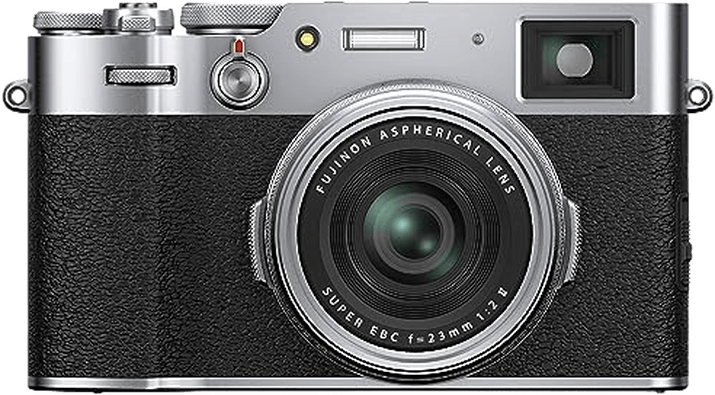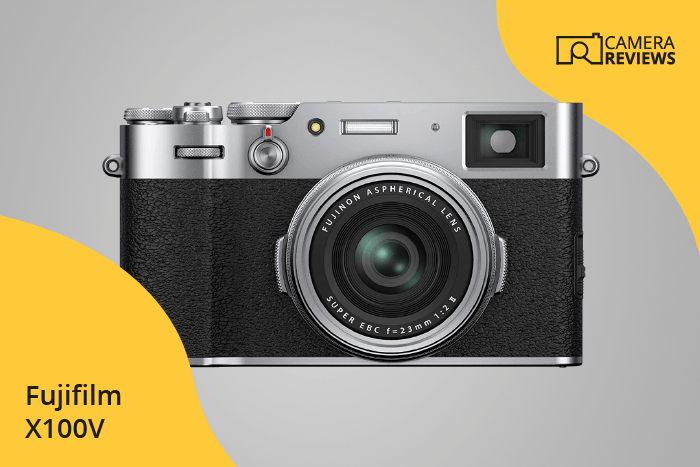Fujifilm X100V Specs and Scores

The Fujifilm X100V scores a solid 69/100. Announced on February 4th, 2020 and priced at $1399, this mirrorless camera has competitive specs for its release year. Measuring 128 x 75 x 53mm and weighing 478g (1.05lbs), the X100V is a compact and lightweight option in today’s market.
While not the highest-scoring camera, the Fujifilm X100V still holds its ground with its specifications. Its size and weight make it a convenient choice for photographers seeking a user-friendly and portable camera.
Fujifilm X100V Overview and Optics
The Fujifilm X100V earns a score of 66/100 for its optics. With 26 megapixels and a shooting speed of 11 frames per second, this camera is equipped with a CMOS sensor and an X-Processor 4. Although there is no DXOMARK score available for Fujifilm cameras, the sensor size is APS-C, which is a standard in today’s market.
One limitation of the X100V is its fixed lens mount, meaning that users cannot change the lens. This may deter photographers who require versatility in their lenses. Additionally, the camera lacks image stabilization, which could result in blurry images when shooting handheld or in low-light conditions. The aspect ratio of 3:2 is standard for most cameras.
Despite these drawbacks, the Fujifilm X100V provides satisfactory performance in its optics. While it may not cater to all photographers’ needs, it remains a solid option for those seeking a compact camera with decent specifications.
Fujifilm X100V Video Performance
The Fujifilm X100V boasts an impressive video score of 91/100. This camera offers a maximum video resolution of 4K, with dimensions reaching 4096 x 2160. Users can capture fast-paced action thanks to its maximum video frame rate of 120fps.
Compared to other cameras in the market, the X100V holds its own when it comes to video capabilities. The 4K resolution and high frame rate provide sharp, detailed footage, making it a strong contender for videographers. Additionally, the built-in time-lapse functionality adds versatility and creative options for users.
The Fujifilm X100V proves to be a reliable and competitive choice for those seeking advanced video capabilities in a camera. Its high score reflects the quality and performance that users can expect when capturing videos with this camera.
Fujifilm X100V Features and Benefits
The Fujifilm X100V boasts a feature score of 85/100, reflecting its impressive array of specifications. The camera features a 3-inch touchscreen with a high resolution of 1,620,000 dots, ensuring crisp, clear image preview and easy navigation. The inclusion of a flip screen further enhances its usability, catering to various shooting angles and creative compositions.
Despite lacking GPS functionality, the X100V compensates with both Wi-Fi and Bluetooth capabilities, allowing for seamless connectivity and image transfer. These attributes contribute to the camera’s competitive standing in the market, where users value both performance and convenience.
The Fujifilm X100V’s remarkable feature score and specifications make it a strong contender among contemporary cameras. Its combination of performance, connectivity, and usability solidifies its position as a reliable and versatile option for photographers.
Fujifilm X100V Storage and Battery
The Fujifilm X100V scores 37/100 for storage and battery. It has a single memory card slot, compatible with SD, SDHC, and SDXC cards, specifically UHS-I. This single slot may not be ideal for professionals seeking more storage options. The battery life offers 420 shots, powered by an NP-W126S battery. Additionally, the camera supports USB charging.
In the current market, the X100V’s storage and battery capabilities may not be the most competitive. However, for casual photographers or those not requiring extensive storage or battery life, the camera remains a viable option.
Fujifilm X100V Alternatives
Do you want to know how the Fujifilm X100V compares to its competitors? Have a look at the most popular comparisons for this camera below:
- Fujifilm X-T5 vs X100V
- Fujifilm X-E4 vs X100V
- Fujifilm X100F vs X100V
- Fujifilm X-T30 II vs X100V
- Canon EOS R7 vs Fujifilm X100V
- Fujifilm X-S10 vs X100V
Fujifilm X100V FAQ
Does the Fujifilm X100V Have Built-in Image Stabilization?
No, the Fujifilm X100V does not have built-in image stabilization. You’ll need to rely on your shooting technique and the camera’s higher ISO capabilities to minimize camera shake.
Does the Fujifilm X100V Support 4K Video Recording?
Yes, the Fujifilm X100V supports 4K video recording at 30fps, providing high-resolution video quality for both casual and advanced users.
What Size Sensor Does The Fujifilm X100V Have?
The Fujifilm X100V features an APS-C sized sensor, providing excellent image quality and performance in a compact form factor.
Does the Fujifilm X100V Have a Dual Memory Card Slot?
No, the Fujifilm X100V has a single memory card slot, which supports UHS-I SD cards.
Does the Fujifilm X100V Have a Touch Screen?
Yes, the Fujifilm X100V features a touch screen, allowing for intuitive control and easy navigation of the camera’s settings and features.
Does the Fujifilm X100V Have Wi-Fi and Bluetooth?
Yes, the Fujifilm X100V is equipped with both Wi-Fi and Bluetooth connectivity, enabling convenient wireless file transfer and remote control capabilities.
Does the Fujifilm X100V Have GPS?
No, the Fujifilm X100V does not have built-in GPS functionality. However, you can use your smartphone’s GPS and wirelessly transfer location data to the camera.
Is the Fujifilm X100V Weather Sealed?
Yes, the Fujifilm X100V is weather sealed, offering protection against dust, moisture, and minor splashes, making it suitable for outdoor shooting in various conditions.
Does the Fujifilm X100V Have a Built-in Flash?
Yes, the Fujifilm X100V includes a built-in flash, providing additional lighting when needed in low-light situations or for creative effects.

